Upon Request Someone Asked For An Anatomy Tutorial! I Kept It Fairly General But If Anyone Wants Something








Upon request someone asked for an anatomy tutorial! I kept it fairly general but if anyone wants something more specific, I’m happy to make a more of them :D
More Posts from Aether1984 and Others

I’ve been thinking about it for a while and I finally had the time to work on a really simple walkthrough of my design process for armors! Hope it can be useful :D
Before designing the attire I like to define first who this character is going to be, based on their alignment, their role, job and so on. I used a random dnd character generator and found a simple but cool prompt:

Based on this brief description the first step to take is to get a good silhouette and pose. Figure drawing and silhouette studies are a good method of exercise: they train you to think without any sort of detail. The pose alone should convey the whole mood. I wanted my human paladin to be an aged veteran knight in medium build, ready to strike and prepared to carry her weight in battle with two swords.

Armor is a tricky subject but only when you don’t know it. I study a lot from real traditional armor, because before designing something I have to figure out how it actually works in real life. I could recommend lots of book to buy but Pinterest does an amazing job in providing you with an endless stream of inspiration and photos/illustrations to study (Osprey Publishing has fantastic books about armor, weapons and military from 10th century and before to 20th century). I believe in functionality over beauty but with a middle ground that makes both aspects look good together instead of clashing (I’m looking at you, Korean concept artists): it’s my job to find a compromise between them. A good example to study is something like this:

Simple, readable, every rivet shown makes it understandable to know how to move into an armor like this. I also take lots of inspiration from fashion design but it’s another whole world lol, https://www.vogue.com/fashion-shows is pretty much the Bible for that since there’s a complete list of every season of pret-a-porter and couture from 1990 to the present day. It’s a fun game to play!
Question yourself when you design, “can I wear this? How? If I were to make a cosplay of this, how would I layer everything?”, if you’re aiming for realism you have to follow certain rules and guidelines. Speaking of guidelines, this is a simplification of the parts of the armor I want for this character.

You can call it a day and be done with it by refining the sketch a bit now. This is a good design, boring but functional. How do we make it more interesting? By using shapes and patterns to create a general theme, adding cloth parts like a cape and undershirt and all the elements needed like belts, chain mail and so on. Rectangles? Amazing. Circles into rectangles?? Beautiful craftsmanship (go wild)

This is looking like a real character now, congrats! Here’s where the fun really begins though: details. Once the silhouette is defined you can customize the character all the way and make it look like there’s a story to be told even in the armor. I like to think of a theme and apply it to pretty much everything, it’s usually animals or flowers because often times knights had themes like those. This woman is a fierce, fearless mom figure, tired but wise, willing to help the young adventurers to see them leave the nest and fly on their own… like a bird… but like, a cool bird? Like a cool bird often associated with freedom?

Eagle theme are all over the armor: it intrigues the viewer and makes the design look complex enough to be interesting on its own. The knee and elbow parts are wings now, one of the pauldrons has a raging eagle coming out of it (asymmetrical details are cool!), the important parts connecting the armor are shown with little details that make it look like a custom made set. At this point I’m satisfied and can go onto colors, then rendering.
Colors take a big part into the character design but it’s not something I feel good enough to cover lol, the only advice I can share regarding this is to have in mind the materials of the outfit. Right now the breastplate is in a grey zone: a slight change in material can turn a decorated breastplate into a half coat. Defining material when you’re sketching is a neat way to save yourself some time and get a bit less stressed when you get to painting.

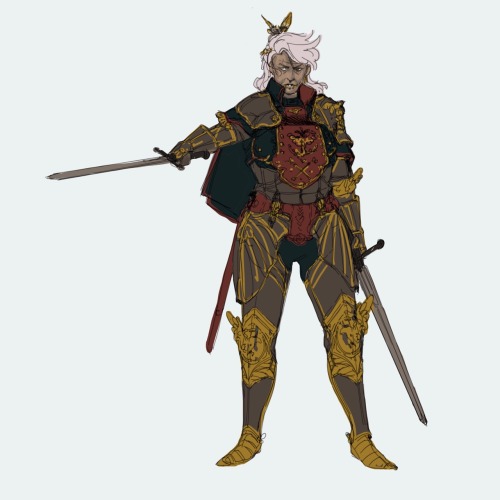
And it’s done! Hope it was helpful!
I just realized how terribly short her right arm is LOL please don’t shame me

On drawing The Other Eye ™
Can you give any tips on how to draw big bulky people like Hazel/Muriel/Gretchen?
I hope this can be helpful to you!

I don’t really think about how I draw characters with different body types at this point because I’ve practiced it so much but these are some rough notes on what I do.
The core of it is to just draw using thicker shapes. Don’t worry too much about exaggeration as it’ll help get you out of the mould of drawing smaller characters by default. The neck, the arms, the torso, the legs, just draw them thicker.
Study references of fat or muscular to see how the definition changes but in principle, it isn’t that much different to drawing any body type.
I draw Hazel and Gretchen to be quite bulky but because they’re teenagers when I draw them, they’re still quite soft and lack extreme definition or sharp lines, unlike when I draw Muriel who’s meant to be extreme and musclebound. Changing how soft you draw the character or how much detail you draw changes whether they look bulky from fat or muscle.
Making this guide because I see this question time and time again on here. This post is mostly directed at white artists and writers who are wondering how to best design their characters of color. Full text description is at the end under the cut.




Full disclaimer, I am biracial (mixed E/SE asian and white) and grew up in majority poc communities, but I am just one person and this post is only based on my own experiences. If any other poc want to chime in, feel free to do so.
Once again, a full plaintext description is under the cut. If you find the information useful, please pass it on by reblogging <3
(Finally, even though I spoke vaguely on genetic inheritance, this is NOT the place to comment on certain features being mutations, as if being a mutation means something is inherently lesser or isn’t supposed to exist. Mutations is everything! All of our traits were at some point or another, an emerging mutation. Love yourself ^__^)
Keep reading
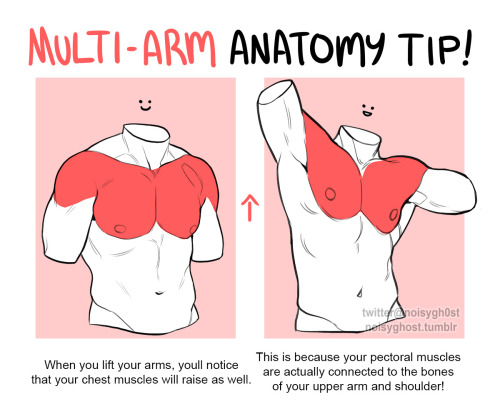
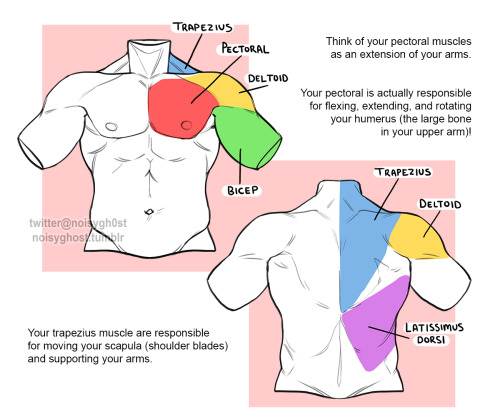
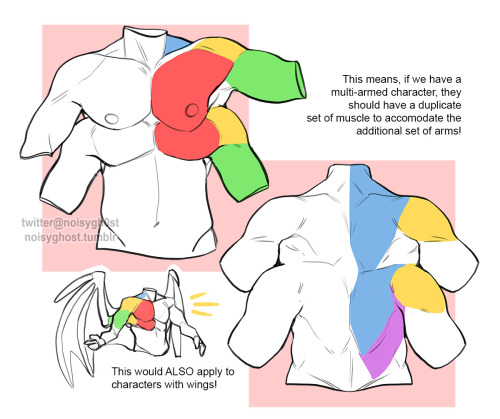
i’m still learning anatomy myself so i wouldn’t use this as more than just a general tip but…. I am fascinated by speculative monster anatomy and this is something i discovered years ago and thought i would impart amongst my fellow monster enthusiasts :)
mind you, the second set of pectorals can look kind of funky so i understand aesthetically why people would prefer not to draw them but! if you are someone interested in anatomy, i think this is a thing people dont really think about when giving their OCs wings/extra limbs and i think it’s kind of neat!



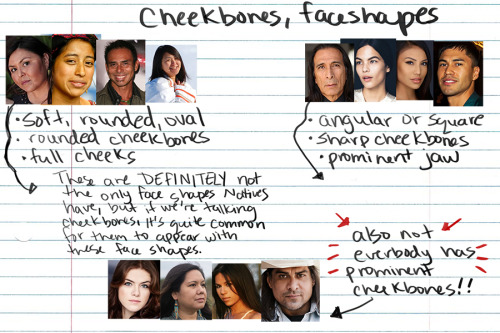

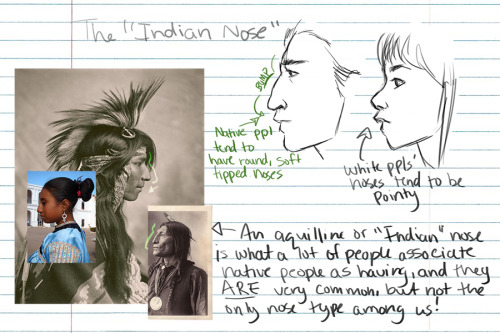
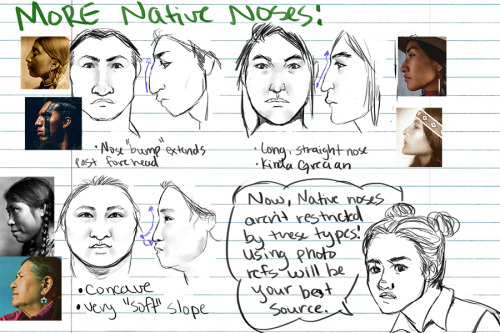
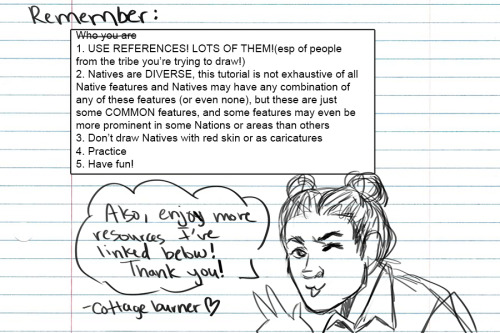
How to Draw Native People: a Tutorial/Reference Guide
As requested, here is a basic guide for how to draw Indigenous peoples (mostly focused on North America)! Also please note that this is not an exhaustive list of Native American phenotypes/features, and more like an intro on very common features that can be found in us, and even then, not altogether at once on a single person’s face. I highly encourage the use of references and care taken into research when drawing. I may do a part 2 that goes slightly more into depth, but for now, enjoy part one.
Resouces:
How to draw Native Skin tutorial (don’t draw us red!)
List of Native American Celebrities, which include their tribe(s) and home country, with 1,250 names, to use for your referencing pleasure
How to draw black people by Peachdeluxe, & Black hair in depth by misslaney for mixed black Natives
How to draw Asian People, a guide by Chuwenjie, for mixed Asian Natives AND because it includes a lovely tutorial on monolid eyes, a shared feature of Native people
get drawin!!








The uh ,,
The wing ?tutorial? Featuring many examples and little to no explanation
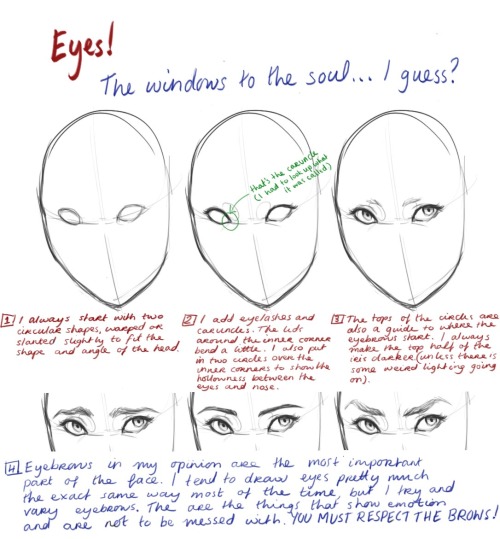



I finally reached 5000 followers *quietly cheers* and @strongity asked me a day before that happened to maybe do a tutorial thing on eyes and anatomy… So I did my best. I have kind of moved past using methods to draw (like using boxes to create shapes), just because I’m so used to drawing people. It kind of became a tips thing rather than a step by step guide, but hopefully it will help some of you!
do you have a reference/tutorial for the way you draw teeth??


I kinda just freehand it myself since i got it memorized but i made one for ya- i hope it’s alright;;v;!!

Male Anatomy
Artist: Brandon McKinney
-
 spicyartereferences reblogged this · 3 months ago
spicyartereferences reblogged this · 3 months ago -
 chicken-nugget-bomb liked this · 3 months ago
chicken-nugget-bomb liked this · 3 months ago -
 artking-4 reblogged this · 4 months ago
artking-4 reblogged this · 4 months ago -
 amphi-lol liked this · 5 months ago
amphi-lol liked this · 5 months ago -
 cutepotootie liked this · 5 months ago
cutepotootie liked this · 5 months ago -
 dragonsrepic1 reblogged this · 5 months ago
dragonsrepic1 reblogged this · 5 months ago -
 dragonsrreblogers1 reblogged this · 5 months ago
dragonsrreblogers1 reblogged this · 5 months ago -
 dragonsrepic1 liked this · 5 months ago
dragonsrepic1 liked this · 5 months ago -
 frostfae-thesoulcrow liked this · 5 months ago
frostfae-thesoulcrow liked this · 5 months ago -
 theeldritchdarling reblogged this · 5 months ago
theeldritchdarling reblogged this · 5 months ago -
 rosetyler42 reblogged this · 5 months ago
rosetyler42 reblogged this · 5 months ago -
 rosetyler42 liked this · 5 months ago
rosetyler42 liked this · 5 months ago -
 givemeallyourpenny liked this · 5 months ago
givemeallyourpenny liked this · 5 months ago -
 artking-4 reblogged this · 5 months ago
artking-4 reblogged this · 5 months ago -
 xinnamoon reblogged this · 6 months ago
xinnamoon reblogged this · 6 months ago -
 lolita7d liked this · 6 months ago
lolita7d liked this · 6 months ago -
 sungfairytales liked this · 6 months ago
sungfairytales liked this · 6 months ago -
 softypyro liked this · 7 months ago
softypyro liked this · 7 months ago -
 britishblueberrybiscuits liked this · 7 months ago
britishblueberrybiscuits liked this · 7 months ago -
 wrenthejester reblogged this · 7 months ago
wrenthejester reblogged this · 7 months ago -
 secretsandsparklingenvy liked this · 7 months ago
secretsandsparklingenvy liked this · 7 months ago -
 aiiizawa liked this · 7 months ago
aiiizawa liked this · 7 months ago -
 noctswife reblogged this · 7 months ago
noctswife reblogged this · 7 months ago -
 silverprism-s liked this · 8 months ago
silverprism-s liked this · 8 months ago -
 silverprism-s reblogged this · 8 months ago
silverprism-s reblogged this · 8 months ago -
 nezjazz reblogged this · 8 months ago
nezjazz reblogged this · 8 months ago -
 broekenwing04 liked this · 8 months ago
broekenwing04 liked this · 8 months ago -
 artking-4 reblogged this · 8 months ago
artking-4 reblogged this · 8 months ago -
 craftyphantombanana liked this · 9 months ago
craftyphantombanana liked this · 9 months ago -
 goddess92a reblogged this · 10 months ago
goddess92a reblogged this · 10 months ago -
 goddess92a liked this · 10 months ago
goddess92a liked this · 10 months ago -
 froggykyu liked this · 11 months ago
froggykyu liked this · 11 months ago -
 vosquez liked this · 11 months ago
vosquez liked this · 11 months ago -
 ette-lette reblogged this · 1 year ago
ette-lette reblogged this · 1 year ago -
 ghostcorerando reblogged this · 1 year ago
ghostcorerando reblogged this · 1 year ago -
 secretmagician liked this · 1 year ago
secretmagician liked this · 1 year ago -
 maywillows liked this · 1 year ago
maywillows liked this · 1 year ago -
 micarocks101 liked this · 1 year ago
micarocks101 liked this · 1 year ago -
 core29394 liked this · 1 year ago
core29394 liked this · 1 year ago -
 luke0217 liked this · 1 year ago
luke0217 liked this · 1 year ago -
 inspectorcrayon liked this · 1 year ago
inspectorcrayon liked this · 1 year ago -
 twineris liked this · 1 year ago
twineris liked this · 1 year ago -
 cauli-flawa reblogged this · 1 year ago
cauli-flawa reblogged this · 1 year ago